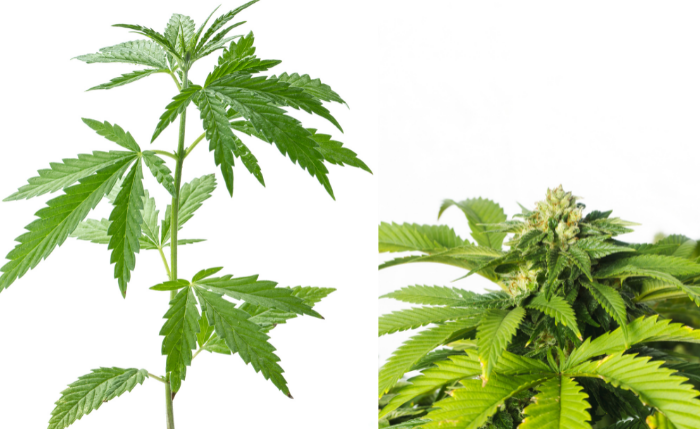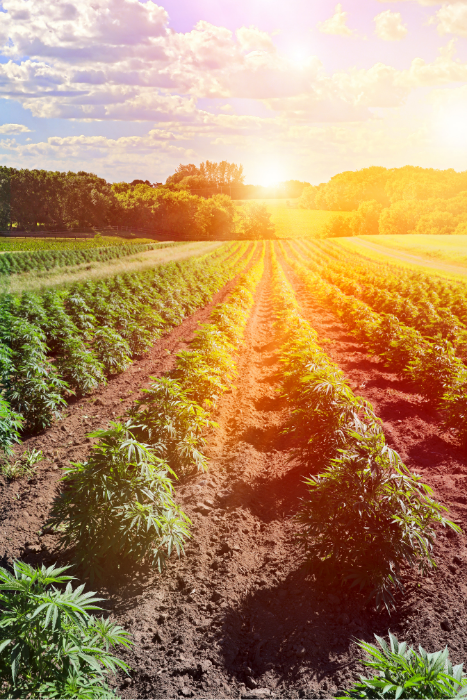While taking your CBD, you may find yourself wondering how it gets from seed to what’s in your bottle. Or, maybe you haven’t wondered that but now you are.
Either way, we wanted to dive in and answer that question!
You could fill a book with the ins and outs of growing hemp. It’s a complex plant with many different things to consider depending on your intentions. Today, we’re simply going to provide an overview of hemp growing for CBD.
But before we get into the growing process, there are a few things to know about hemp first.
What is hemp?

Hemp is a member of the Cannabis sativa. L plant species, just like marijuana. Despite this similarity, hemp and marijuana have different biological structures which give them both their own unique properties.
A concern or question many people have about CBD is whether or not it’s marijuana. But this is where the stark difference lies – one comes from hemp and the other from the marijuana plant. Even though they’re both members of the Cannabis sativa L. species, they’re not the same.
The difference is clear just in the way these two plants look. While marijuana has thick, dense buds and grows to be more of a bush, hemp is tall and thin, free of the buds seen on marijuana.
However, the biggest difference between the two comes down to the THC. This is the cannabinoid in marijuana responsible for the psychoactive effects, ie. the “high” feeling you get from the plant. In marijuana, THC content is generally anywhere between 5-30%, and sometimes even higher. In hemp, THC content is no more than 0.3%. This means there’s no “getting high” with hemp.
What is hemp used for?
Hemp is a very versatile plant. And to top it off, it grows quickly and easily. That being said, depending on what you’re growing it for, you would want to be mindful of certain variables (sex of the plant, growing conditions, harvesting techniques, etc.)
The different variations and how to care for them are why there are entire books on growing and caring for hemp plants.
Here are a few of the hemp’s many uses:
Phytoremediation – This is the process of plants cleaning the soil they live in by extracting and absorbing pollutants. Hemp has been shown to be quite effective at this.
Fiber – Farming hemp for fiber is typically done on a large-scale production and has been carried out for years. Fibrous types of hemp can be grown to produce paper, textiles, fuel, building materials, and much more.
Seed/grain – Hemp seeds are extremely nutritious. These variations of hemp plants contain less cannabinoids, but their seeds offer many health benefits. When growing hemp for these seeds, farmers need to handle the planting, processing, and transporting with care as they are quite delicate.
Cannabinoids – Hemp with cannabinoids are quite popular, as they contain the highly coveted cannabidiol (CBD). It takes a special skill to harvest these types of hemp plants for optimal CBD levels, while keeping THC levels low.
If you were a farmer looking to grow hemp, you would first want to know what you wanted the hemp for and subsequently decide which type of hemp to grow. From there, you would plant, maintain, harvest, and handle the hemp plants accordingly.
Growing hemp for CBD
Cannabis will grow almost anywhere, anytime. But if you’re growing hemp for CBD, you want to be growing the highest quality hemp possible, giving each plant the love and care it needs to thrive.
When growing for CBD, here’s what you want to look out for:
Seeds – You want to make sure you have seeds of the highest quality. Hemp grown for CBD typically only employs female plants because male and female plants grown together will increase seed production while decreasing CBD levels. For this reason, most farmers would opt for feminized seeds.

Soil – Hemp does better in some soil than others, preferring a pH level between 6.0-7.5. Loamy soil that’s aerated, rich in organic matter, and extremely fertile is best. It should also be supplemented with mineral- and nitrogen-rich fertilizer if needed so that the plants can thrive throughout the growing season.
Sun – Sure, they’ll grow anywhere, but hemp plants love the sun. They will grow in as little as six hours of sun per day, but they will thrive in as much sun as you can provide them with (twelve hours or more, if possible). In North America, they’re best planted in early- to mid-spring.
Water – Throughout its growth cycle, hemp will need 20-30 inches of rainfall. If this can’t be met naturally, an irrigation system will have to be substituted. Lots of water is required during the germination period, and as the plant grows so will absorption – meaning even more water.
Pest/disease control – Like any plant, hemp can be subject to pests and disease. Things to look out for are viruses, bacterial and fungal infections, root rot, and blight, with white and gray mold historically being hemp’s greatest menace. To avoid disease build-up, a four year crop rotation is recommended for hemp.
Harvesting – Hemp for CBD is typically harvested in October when cannabinoid levels are at their highest. From there, they are dried and cured. Then the CBD can be extracted through several means. To learn more about CBD extraction, click here.
CBD from seed to oil
Here at SomaLeaf, we use single origin, organic, and non-GMO hemp grown in California. Our farm uses progressive organic and sustainable farming techniques by fourth and fifth generation farmers that have been there for over a century. Our hemp is grown on a 10,000 acre farm that has been family owned since the early 1900s. It rests on a rich bed of loam soil on an ancient alluvial flood plain that is ideal for growing hemp.
It’s one of the things that allows SomaLeaf’s Liposomal CBD Turmeric RELIEF to be one of the best, most effective CBDs on the market.





